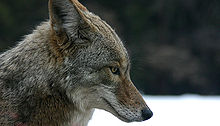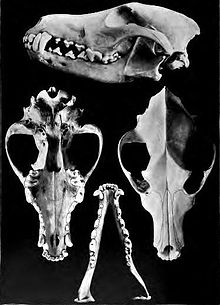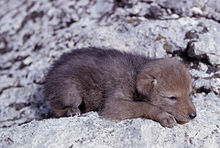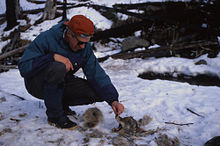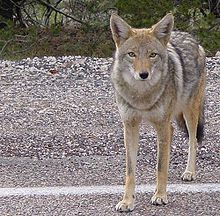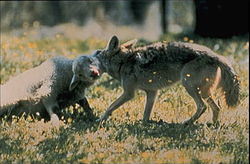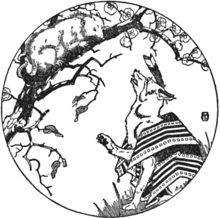- Coyote
-
Coyote 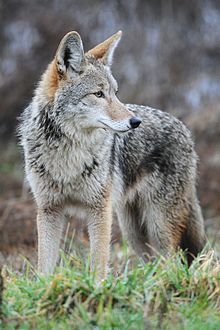
Conservation status Scientific classification Kingdom: Animalia Phylum: Chordata Class: Mammalia Infraclass: Eutheria Order: Carnivora Family: Canidae Genus: Canis Species: C. latrans Binomial name Canis latrans
Say, 1823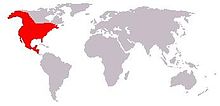
Coyote range The coyote (US: /kaɪˈoʊtiː/ or /ˈkaɪ.oʊt/, UK: /kɔɪˈjoʊteɪ/ or /kɔɪˈjoʊt/;[2] Canis latrans), also known as the American jackal or the prairie wolf, is a species of canine found throughout North and Central America, ranging from Panama in the south, north through Mexico, the United States and Canada. It occurs as far north as Alaska and all but the northernmost portions of Canada.[3]
There are currently 19 recognized subspecies, with 16 in Canada, Mexico and the United States, and 3 in Central America.[4] Unlike its cousin the gray wolf, which is Eurasian in origin, evolutionary theory suggests the coyote evolved in North America during the Pleistocene epoch 1.81 million years ago[5] alongside the Dire Wolf.[6] Unlike the wolf, the coyote's range has expanded in the wake of human civilization, and coyotes readily reproduce in metropolitan areas.[7][8]
Contents
Name
The name "coyote" is borrowed from Mexican Spanish coyote, ultimately derived from the Nahuatl word cóyotl.[9] Its scientific name, Canis latrans, means "barking dog" in Latin.[10] Preliminary genetic evidence, however, has shown that "coyotes" in some areas are, genetically speaking, 85–90% Canis latrans, and from 10 to 15% Canis lupus (gray wolf), along with some domestic dog (Canis lupus familiaris) DNA; this prompted one researcher to suggest, jokingly, that they be called "Canis soupus," as they are a "soup" (mixture) of canid species.[11]
Description
The color of the coyote's pelt varies from grayish-brown to yellowish-gray on the upper parts, while the throat and belly tend to have a buff or white color. The forelegs, sides of the head, muzzle and paws are reddish-brown. The back has tawny-colored underfur and long, black-tipped guard hairs that form a black dorsal stripe and a dark cross on the shoulder area. The black-tipped tail has a scent gland located on its dorsal base. Coyotes shed once a year, beginning in May with light hair loss, ending in July after heavy shedding. The ears are proportionately large in relation to the head, while the feet are relatively small in relation to the rest of the body.[3] Certain experts have noted the shape of a domestic dog's brain case is closer to the coyote's in shape than that of a wolf's. Mountain-dwelling coyotes tend to be dark-furred, while desert coyotes tend to be more light brown in color.[4]
Coyotes typically grow to 30–34 in (76–86 cm) in length, not counting a tail of 12–16 in (30–41 cm), stand about 23–26 in (58–66 cm) at the shoulder and, on average, weigh from 15–46 lb (6.8–21 kg).[3][12] Northern coyotes are typically larger than southern subspecies, with the largest coyotes on record weighing 74.75 pounds (33.91 kg) and measuring 1.75 m (5.7 ft) in total length.[13][14]
The coyote's dental formula is I 3/3, C 1/1, Pm 4/4, M usually 2/2, occasionally 3/3, 3/2, or 2/3 × 2 = 40, 44, or 42[15] Normal spacing between the upper canine teeth is 29–35 millimetres (1.1–1.4 in) and 25–32 millimetres (0.98–1.3 in) between the lower canine teeth.[16]
Dentition 3,1,4,2 3,1,4,2 The upper frequency limit of hearing for coyotes is 80 kHz, compared to the 60 kHz of domestic dogs.[17] Compared to wolves, and similar to domestic dogs, coyotes have a higher density of sweat glands on their paw pads. This trait, however, is absent in the large New England coyotes, which are thought to have some wolf ancestry.[18]
During pursuit, a coyote may reach speeds up to 43 mph (69 km/h),[19] and can jump a distance of over 13 ft (4 m).[3]
Behavior
Though coyotes have been observed to travel in large groups, they primarily hunt in pairs. Typical packs consist of six, closely related adults, yearlings and young. Coyote packs are generally smaller than wolf packs, and associations between individuals are less stable,[20] thus making their social behavior more in line with that of the dingo.[21] In theory, this is due to an earlier expression of aggression, and the fact that coyotes reach their full growth in their first year, unlike wolves, which reach it in their second.[20] Common names of coyote groups are a band, a pack, or a rout.[22] Coyotes are primarily nocturnal, but can often be seen during daylight hours.[3] They were once essentially diurnal, but have adapted to more nocturnal behavior with pressure from humans.[23]
Coyotes are capable of digging their own burrows, though they often prefer the burrows of groundhogs or American badgers. Coyote territorial ranges can be as much as 19 kilometers in diameter around the den, and travel occurs along fixed trails.[3]
In areas where wolves have been exterminated, coyotes usually flourish. For example, as New England became increasingly settled and the resident wolves were eliminated, the coyote population increased, filling the empty ecological niche. Coyotes appear better able than wolves to live among people.[24]
Coyotes have been known to live a maximum of 10 years in the wild and 18 years in captivity.[3] They seem to be better than dogs at observational learning.[18]
Reproduction
Female coyotes are monoestrous, and remain in estrus for two to five days between late January and late March, during which mating occurs. Once the female chooses a partner, the mated pair may remain temporarily monogamous for a number of years. Depending on geographic location, spermatogenesis in males takes around 54 days, and occurs between January and February. The gestation period lasts from 60 to 63 days. Litter size ranges from one to 19 pups; the average is six.[3] These large litters act as compensatory measures against the high juvenile mortality rate – about 50–70% of pups do not survive to adulthood.[25] The pups weigh approximately 250 grams at birth, and are initially blind and limp-eared.[3] Coyote growth rate is faster than that of wolves, being similar in length to that of the dhole.[26] The eyes open and ears become erect after 10 days. Around 21–28 days after birth, the young begin to emerge from the den, and by 35 days, they are fully weaned. Both parents feed the weaned pups with regurgitated food. Male pups will disperse from their dens between months six and 9, while females usually remain with the parents and form the basis of the pack. The pups attain full growth between 9 and 12 months old. Sexual maturity is reached by 12 months.[3] Unlike wolves, mother coyotes will tolerate other lactating females in their pack.[27]
Interspecific hybridization
Coyotes will sometimes mate with domestic dogs, usually in areas such as Texas and Oklahoma, where the coyotes are plentiful and the breeding season is extended because of the warm weather. The resulting hybrids, called coydogs, maintain the coyote's predatory nature, along with the dog's lack of timidity toward humans, making them a more serious threat to livestock than pure-blooded animals. This crossbreeding has the added effect of confusing the breeding cycle. Coyotes usually breed only once a year, while coydogs will breed year-round, producing many more pups than a wild coyote. Differences in the ears and tail generally can be used to distinguish coydogs from domestic or feral dogs or pure coyotes.[28] Breeding experiments in Germany with poodles, coyotes, and later on with the resulting dog-coyote hybrids showed that, unlike wolfdogs, coydogs exhibit a decrease in fertility, significant communication problems, and an increase of genetic diseases after three generations of interbreeding.[29]
Coyotes have also been known, on occasion, to mate with wolves, though this is less common than with dogs, due to the wolf's hostility to the coyote. The offspring, known as a coywolf, is generally intermediate in size to both parents, being larger than a pure coyote, but smaller than a pure wolf. A study showed that of 100 coyotes collected in Maine, 22 had half or more wolf ancestry, and one was 89% wolf. The large eastern coyotes in Canada are proposed to be actually hybrids of the smaller western coyotes and wolves that met and mated decades ago, as the coyotes moved toward New England from their earlier western ranges.[24] Ontario Ministry of Natural Resources research scientist Brent Patterson has revealed findings that most coyotes in Eastern Ontario are wolf-coyote hybrids and that the Eastern wolves in Algonquin Park are, in general, not interbreeding with coyotes.[30]
The red wolf is thought by certain scientists to be in fact a wolf/coyote hybrid rather than a unique species. Strong evidence for hybridization was found through genetic testing, which showed red wolves have only 5% of their alleles unique from either gray wolves or coyotes. Genetic distance calculations have indicated red wolves are intermediate between coyotes and gray wolves, and they bear great similarity to wolf/coyote hybrids in southern Quebec and Minnesota. Analyses of mitochondrial DNA showed the existing red wolf populations are predominantly coyote in origin.[31]
Communication
The calls a coyote makes are high-pitched and variously described as howls, yips, yelps, and barks. These calls may be a long rising and falling note (a howl) or a series of short notes (yips). These calls are most often heard at dusk or night, but may sometimes be heard in the day, even in the middle of the day. Although these calls are made throughout the year, they are most common during the spring mating season and in the fall when the pups leave their families to establish new territories. When a coyote calls its pack together, it howls at one high note. When the pack is together, it howls higher and higher, and then they yip and yelp and also do a yi-yi sound, very shrill, with the howl.
Ecology
Diet and hunting
Coyotes are opportunistic, versatile carnivores with a 90% mammalian diet, depending on the season. They primarily eat small mammals, such as voles, prairie dogs, eastern cottontails, ground squirrels, and mice, though they will eat birds, snakes, lizards, deer, javelina, and livestock, as well as large insects and other large invertebrates. The coyote will also target any species of bird that nests on the ground. Though they will consume large amounts of carrion, they tend to prefer fresh meat. Fruits and vegetables are a significant part of the coyote's diet in the autumn and winter months. Part of the coyote's success as a species is its dietary adaptability. As such, coyotes have been known to eat human rubbish and domestic pets. They catch cats and dogs when they come too close to the pack. Urban populations of coyotes have been known to actively hunt cats, and to leap shorter fences to take small dogs. In particularly bold urban packs, coyotes have also been reported to shadow human joggers or larger dogs, and even to take small dogs while the dog is still on a leash. However, this behavior is often reported when normal urban prey, such as brown rats, black rats and rabbits, have become scarce. Yet, confirmed reports of coyotes killing a human have been documented.[3][32] A recent trail cam uncovered two or three coyotes killing a large deer.[33]
Though the coyote is the basis for the character of Wile E. Coyote in the Warner Brothers Looney Tunes and Merrie Melodies animated cartoons, especially about the Road Runner, coyotes have not been known as yet to attack greater roadrunners for prey.
Coyotes shift their hunting techniques in accordance with their prey. When hunting small animals such as mice, they slowly stalk through the grass, and use their acute sense of smell to track down the prey. When the prey is located, the coyotes stiffen and pounce on the prey in a cat-like manner. Coyotes will commonly work in teams when hunting large ungulates such as deer, which is more common in winter (when large prey is likely weakened) and in larger-bodied northern coyotes. Coyotes may take turns in baiting and pursuing the deer to exhaustion, or they may drive it towards a hidden member of the pack.[3] When attacking large prey, coyotes attack from the rear and the flanks of their prey. Occasionally, they also grab the neck and head, pulling the animal down to the ground. Coyotes are persistent hunters, with successful attacks sometimes lasting as long as 21 hours; even unsuccessful ones can continue more than eight hours before the coyotes give up. Depth of snow can affect the likelihood of a successful kill.[34] Packs of coyotes can bring down prey as large as adult elk, which usually weigh over 250 kg (550 lbs).[35]
The average distance covered in a night's hunting is 2.5 miles (4.0 km).[3]
Interspecific predatory relationships
The gray wolf is a significant predator of coyotes wherever their ranges overlap. Since the Yellowstone gray wolf reintroduction in 1995 and 1996, the local coyote population went through a dramatic restructuring. Until the wolves returned, Yellowstone National Park had one of the densest and most stable coyote populations in America due to a lack of human impacts. Two years after the wolf reintroductions, the population of coyotes had been reduced 50% through both competitive exclusion and intraguild predation compared to before their reintroduction. In Grand Teton, coyote densities were 33% lower than normal in the areas where they coexisted with wolves, and 39% lower in the areas of Yellowstone where wolves were reintroduced. In one study, about 16% of radio-collared coyotes were preyed upon by wolves. Yellowstone coyotes have had to shift their territories as a result, moving from open meadows to steep terrain. Carcasses in the open no longer attract coyotes; when a coyote is chased on flat terrain, it is often killed. They feel more secure on steep terrain, where they will often lead a pursuing wolf downhill. As the wolf comes after it, the coyote will turn around and run uphill. Wolves, being heavier, cannot stop and the coyote gains a large lead. Though physical confrontations between the two species are usually dominated by the larger wolves, coyotes have been known to attack wolves if they outnumber them. Both species will kill each other's pups, given the opportunity.[36][37] Wolf urine has been marketed and claimed to be an organic coyote deterrent, such as for deterring attacks on sheep.[38]
Cougars sometimes kill coyotes. The coyote's instinctive fear of cougars has led to the development of sound systems which repel coyotes from public places by replicating the sounds of a cougar.[39] Rarely, bears can also kill coyotes, more likely in competitive rather than predatory attacks. However, both cougars and bears have been displaced from carcasses by coyote packs.[40]
In sympatric populations of coyotes and red foxes, fox territories tend to be located largely outside of coyote territories. The principal cause of this separation is believed to be active avoidance of coyotes by the foxes. Interactions between the two species vary in nature, ranging from active antagonism to indifference. The majority of aggressive encounters are initiated by coyotes, and there are few reports of red foxes acting aggressively toward coyotes except when attacked or when their pups were approached. Conversely, foxes and coyotes have sometimes been seen feeding together.[41] In southern California, coyotes frequently kill gray foxes, and these smaller canids tend to avoid areas with high coyote densities.[42]
Coyotes will sometimes form a symbiotic relationship with American badgers. Because coyotes are not very effective at digging rodents out of their burrows, they will chase the animals while they are above ground. Badgers, on the other hand, are not fast runners, but are well-adapted to digging. When hunting together, they effectively leave little escape for prey in the area.[3]
In some areas, coyotes share their ranges with bobcats. It is rare for these two similarly sized species to physically confront one another, though bobcat populations tend to diminish in areas with high coyote densities.[43] However, several studies have demonstrated interference competition between coyotes and bobcats, and in all cases coyotes dominated the interaction.[44] Multiple researchers[42][45][46][47][48][49] all reported instances of coyotes killing bobcats, whereas bobcats killing coyotes is more rare.[44] Coyotes attack bobcats using a bite-and-shake method similar to that used on medium-sized prey. Coyotes (both single individuals and groups) have been known to occasionally kill bobcats – in most cases, the bobcats were relatively small specimens, such as adult females and juveniles.[50] However, coyote attacks (by an unknown number of coyotes) on adult male bobcats have occurred. In California, coyote and bobcat populations are not negatively correlated across different habitat types, but predation by coyotes is an important source of mortality in bobcats.[42]
Coyotes have also competed with and occasionally eaten Canada lynxes in areas where both species overlap.[44][51]
Relationship with humans
Adaptation to human environment
Despite being extensively hunted, the coyote is one of the few medium-to-large-sized animals that has enlarged its range since human encroachment began. It originally ranged primarily in the western half of North America, but it has adapted readily to the changes caused by human presence and, since the early 19th century, has been steadily and dramatically extending its range.[52] Sightings now commonly occur in a majority of the United States and Canada.[53] Coyotes inhabit nearly every contiguous U.S. state and Alaska. Coyotes have moved into most of the areas of North America formerly occupied by wolves, and are often observed foraging in suburban garbage bins.
Coyotes thrive in suburban settings and even some urban ones. A study by wildlife ecologists at Ohio State University yielded some surprising findings in this regard. Researchers studied coyote populations in Chicago over a seven-year period (2000–2007), proposing that coyotes have adapted well to living in densely populated urban environments while avoiding contact with humans. They found, among other things, that urban coyotes tend to live longer than their rural counterparts, kill rodents and small pets, and live anywhere from parks to industrial areas. The researchers estimate that there are up to 2,000 coyotes living in "the greater Chicago area" and that this circumstance may well apply to many other urban landscapes in North America.[54] In Washington, D.C.'s Rock Creek Park, coyotes den and raise their young, scavenge roadkill, and hunt rodents. "I don't see it as a bad thing for a park," the assigned National Park Service biologist told a reporter for Smithsonian Magazine (March 2006). "I see it as good for keeping animal populations in control, like the squirrels and the mice."
In another testament to the coyote's habitat adaptability, a coyote nicknamed "Hal" made his way to New York City's Central Park in March 2006, wandering about the park for at least two days before being captured by officials. New York's parks commissioner Adrian Benepe noted this coyote had to be very "adventurous" and "curious" to get so far into the city.[55] An incident also occurred in April 2007 in the Chicago Loop district, where a coyote, later nicknamed "Adrian", quietly entered a Quizno's restaurant during the lunch hours; it was later captured and released at a wildlife rehab center near Barrington, Illinois.[56][57] In February 2010, up to three coyotes were spotted on the Columbia University campus, and another coyote sighting occurred in Central Park.[58]
Coyotes are difficult to tame, except when raised from a very young pup, and even then, much of their wild temperament shows when they reach puberty. Coyotes have never been domesticated (not the same thing as tamed) with the exception of some Native American tribes, such as the Hare Indians[59] of northern Canada, who used Hare Indian Dogs, which were either domesticated coyotes or a dog-coyote hybrid, for hunting.[60] The Hare Indian dog, however, in recent years, has become so intermixed with the domestic dog as to be an essentially extinct breed.[61]
Attacks on humans
Coyote attacks on humans are uncommon and rarely cause serious injuries, due to the relatively small size of the coyote. However, coyote attacks on humans have increased since 1998 in the state of California. Data from USDA Wildlife Services, the California Department of Fish & Game, and other sources show that while 41 attacks occurred during the period of 1988–1997, 48 attacks were verified from 1998 through 2003. The majority of these incidents occurred in Southern California near the suburban-wildland interface.[62]
Due to an absence of harassment by residents, urban coyotes lose their natural fear of humans, which is further worsened by people intentionally feeding coyotes. In such situations, some coyotes have begun to act aggressively toward humans, chasing joggers and bicyclists, confronting people walking their dogs, and stalking small children.[62] Non-rabid coyotes in these areas will sometimes target small children, mostly under the age of 10, though some adults have been bitten. In June 2010 a 3-year-old girl and a 6-year-old girl were attacked and seriously injured in separate attacks by coyotes in Rye, New York, a suburb of New York City. The 6-year-old was attacked by two coyotes on June 25 and the 3-year-old was attacked by one coyote on June 29. There was no indication the animals were rabid, but the girls were given treatment as a precaution.[63][64] In June 2011 an unattended toddler on a trampoline was attacked by a coyote which tried to drag her into the woods in North Carolina.[65]
There are only two recorded fatalities in North America from coyote attacks. In 1981 in Glendale, California, a coyote attacked toddler Kelly Keen, who was rescued by her father, but died in surgery due to blood loss and a broken neck.[62][66] In October 2009, Taylor Mitchell, a 19-year-old folk singer on tour, died from injuries sustained in an attack by a pair of coyotes while hiking in the Skyline Trail of the Cape Breton Highlands National Park in Nova Scotia, Canada.[67] Recent studies have shown, however, that the large northeastern coyotes responsible for this attack may in fact be coyote-wolf hybrids (or coywolves) due to absorption of wolves when coyotes moved into eastern North America.[68]
Livestock and pet predation
Coyotes are presently the most abundant livestock predators in western North America, causing the majority of sheep, goat and cattle losses.[16] For example, according to the National Agricultural Statistics Service, coyotes were responsible for 60.5% of the 224,000 sheep deaths that were attributed to predation in 2004.[69] The total number of sheep deaths in 2004 comprised 2.22% of the total sheep and lamb population in the United States.[70] According to the National Agricultural Statistics Service USDA report, "All sheep and lamb inventory in the United States on July 1, 2005, totaled 7.80 million head, 2% above July 1, 2004. Breeding sheep inventory at 4.66 million head on July 1, 2005 was 2% above July 1, 2004."[71] By virtue of the fact that coyote populations are typically many times greater and more widely distributed than those of wolves, coyotes cause more overall predation losses. However, an Idaho census taken in 2005 showed that individual coyotes were one-twentieth as likely to attack livestock than individual wolves.[72]
Coyotes will typically bite the throat just behind the jaw and below the ear when attacking adult sheep or goats, with death commonly resulting from suffocation. Blood loss is usually a secondary cause of death. Calves and heavily-fleeced sheep are killed by attacking the flanks or hind-quarters, causing shock and blood loss. When attacking smaller prey, such as young lambs, the kill is made by biting the skull and spinal regions, causing massive tissue and ossular damage. Small or young prey may be completely carried off, leaving only blood as evidence of a kill. Coyotes will usually leave the hide and most of the skeleton of larger animals relatively intact, unless food is scarce, in which case they may leave only the largest bones. Scattered bits of wool, skin and other parts are characteristic where coyotes feed extensively on larger carcasses.[16]
Coyote predation can usually be distinguished from dog or coydog predation by the fact that coyotes partially consume their victims. Tracks are also an important factor in distinguishing coyote from dog predation. Coyote tracks tend to be more oval-shaped and compact than those of domestic dogs, plus, claw marks are less prominent and the tracks tend to follow a straight line more closely than those of dogs. With the exception of sighthounds, most dogs of similar weight to coyotes have a slightly shorter stride.[16] Coyote kills can be distinguished from wolf kills by the fact that there is less damage to the underlying tissues. Also, coyote scats tend to be smaller than wolf scats.[73]
The U.S. government routinely shoots, poisons, traps and kills 90,000 coyotes each year to protect livestock.[74]
Coyotes are often attracted to dog food and animals that are small enough to appear as prey. Items like garbage, pet food, and sometimes feeding stations for birds and squirrels will attract coyotes into backyards. Approximately 3 to 5 pets attacked by coyotes are brought into the Animal Urgent Care hospital of south Orange County (California) each week, the majority of which are dogs, since cats typically do not survive the attacks.[75] Scat analysis collected near Claremont, California revealed that coyotes relied heavily on pets as a food source in winter and spring.[62] At one location in Southern California, coyotes began relying on a colony of feral cats as a food source. Over time, the coyotes killed most of the cats, and then continued to eat the cat food placed daily at the colony site by citizens who were maintaining the cat colony.[62] Coyotes usually attack smaller sized dogs, but they have been known to attack even large, powerful breeds like the Rottweiler in exceptional cases.[76] Dogs larger than coyotes are generally able to drive them off, and have been known to kill coyotes. Smaller breeds are more likely to suffer injury or death.
Pelts
In the early days of European settlement in North Dakota, American Beavers were the most valued and sought after furbearers, though other species were also taken, including coyotes.[77] Coyotes are an important furbearer in the region. During the 1983–86 seasons, North Dakota buyers purchased an average of 7,913 pelts annually, for an average annual combined return to takers of $255,458. In 1986–87, South Dakota buyers purchased 8,149 pelts for a total of $349,674 to takers.[78]
The harvest of coyote pelts in Texas has varied over the past few decades, but has generally followed a downward trend. A study from the Texas Parks and Wildlife Department, however, found that there was no indication of population decline, and suggested that, as pelt prices were not increasing, the decrease in harvest was likely due to decreasing demand, and not increasing scarcity (where pelt prices would go up.) It suggested that fashion, and the changing custom of wearing fur garments, may be significant among these factors.[79]
Today, coyote fur is still used for full coats and trim and is particularly popular for men’s coats.[80]
Character in mythology
Traditional stories from many Native American, First Nations, and Aboriginal cultures include a deity whose name is translated into English as Coyote. Although especially common in stories told by southwestern Native American nations, such as the Diné and Apache, stories about Coyote appear in dozens of Native American nations from Canada to Mexico.
Usually appearing as a trickster, a culture hero or both, Coyote also often appears in creation myths and etiological myths. Although often appearing in stories as male, Coyote can be female, hermaphrodite, or gender changing, in traditional Aboriginal stories.
Contemporary cultural references
The coyote is a popular figure in folklore and popular culture. References may invoke either the animal or the mythological figure. Traits commonly described in pop culture appearances include inventiveness, mischievousness, and evasiveness. By far, the best known representation is the animated Wile E. Coyote, Super Genius, whose popularity has spread the three-syllable Spanish pronunciation of the word coyote throughout English-speaking North America.
Coyote is also a slang term for a person who smuggles illegal immigrants over the border from Mexico to the United States.
The Phoenix Coyotes are a National Hockey League franchise based in Arizona.
Teams at the University of South Dakota and the College of Idaho are "Coyotes".
The NBA San Antonio Spurs mascot is "The Coyote", as well.
The Daily Coyote is a blog documenting the life of Charlie, a coyote domestically raised since he was a pup. [81]
Taxonomy
Subspecies
There are 19 recognized subspecies of coyote:[82]
- C. l. cagottis (Hamilton-Smith): Mexican coyote – states of Oaxaca, San Luis Potosi, Puebla, and Veracruz in Mexico[83]
- C. l. clepticus (Elliot): San Pedro Martir coyote – northern Baja California and southwestern California[83]
- C. l. dickeyi: Salvador coyote
- C. l. frustor (Woodhouse): Southeastern coyote – southeastern and extreme eastern Kansas, Oklahoma, Texas, Missouri, and Arkansas[83]
- C. l. goldmani: Belize coyote
- C. l. hondurensis: Honduras coyote
- C. l. impavidus (Allen): Durango coyote – southern Sonora, extreme southwestern Chihuahua, western Durango, western Zacatecas, and Sinaloa[83]
- C. l. incolatus (Hall): Northern Coyote – Yukon, Northwest Territories, northern British Columbia, and northern Alberta, and Alaska[83]
- C. l. jamesi (Townsend): Tiburón Island coyote – Tiburón Island[83]
- C. l. latrans: Plains coyote – Great Plains from Alberta, Manitoba, and Saskatchewan south to New Mexico and the Texas Panhandle[83]
- C. l. lestes (Merriam): Mountain coyote – British Columbia and southeastern Alberta south to Utah and Nevada[83]
- C. l. mearnsi (Merriam): Mearns coyote – southwestern Colorado and southern Utah south to northern Sonora and Chihuahua[83]
- C. l. microdon (Merriam): Lower Rio Grande coyote – southern Texas and northern Tamaulipas[83]
- C. l. ochropus (Eschscholtz): California Valley coyote – California west of the Sierra Nevada[83]
- C. l. peninsulae (Merriam): Peninsula coyote – Baja California[83]
- C. l. texensis (Bailey): Texas Plains coyote – most of Texas, eastern New Mexico, and northeastern Mexico[83]
- C. l. thamnos (Jackson): Northeastern coyote – range extends from north-central Saskatchewan east to southern Ontario, south to northern Indiana and west to Missouri[83]
- C. l. umpquensis (Jackson): Northwest Coast coyote – coast of Washington and Oregon[83]
- C. l. vigilis (Merriam): Colima coyote – Pacific coast of Mexico from Jalisco south to Guerrero[83]
Genus controversy
In 1816, in the third volume of Lorenz Oken's Lehrbuch der Naturgeschichte, the author found sufficient similarities in the dentition of coyotes and jackals to place these species into a new separate genus from Canis called Thos after the classical Greek word θώς (jackal). Oken's idiosyncratic nomenclatorial ways, however, aroused the scorn of a number of zoological systematists. Nearly all the descriptive words used to justify the genus division were relative terms without a reference measure, and the argument did not take into account the size differences between the species, which can be considerable. Angel Cabrera, in his 1932 monograph on the mammals of Morocco, briefly touched upon the question of whether or not the presence of a cingulum on the upper molars of the jackals and its corresponding absence in the rest of Canis could justify a subdivision of the genus Canis. In practice, he chose the undivided-genus alternative and referred to the jackals as Canis.[84] A few authors, however, Ernest Thompson Seton being among them, accepted Oken's nomenclature, and went as far as referring to the coyote as American jackal.[85]
The Oken/Heller proposal of the new genus Thos did not affect the classification of the coyote. Gerrit S. Miller still had in his 1924 edition of List of North American Recent Mammals in the section “Genus Canis Linnaeas,” the subordinate heading “Subgenus Thos Oken” and backed it up with a reference to Heller. In the reworked version of the book in 1955, Philip Hershkovitz and Hartley Jackson led him to drop Thos both as an available scientific term and as a viable subgenus of Canis. In his definitive study of the taxonomy of the coyote, Jackson had, in response to Miller, queried whether Heller had seriously looked at specimens of coyotes prior to his 1914 article, and thought the characters to be “not sufficiently important or stable to warrant subgeneric recognition for the group”.[84]
References
- ^ Sillero-Zubiri & Hoffmann (2008). Canis latrans. In: IUCN 2008. IUCN Red List of Threatened Species. Downloaded on May 5, 2008. Database entry includes justification for why this species is of least concern
- ^ Respelled US ky-oh-tee, ky-oht and UK koy-yoh-tay, koy-yoht
- ^ a b c d e f g h i j k l m n "Canis latrans". Animal Diversity Web. http://animaldiversity.ummz.umich.edu/site/accounts/information/Canis_latrans.html. Retrieved August 15, 2007.
- ^ a b "Coyote". Lioncrusher's Domain. http://www.lioncrusher.com/animal.asp?animal=11. Retrieved August 15, 2007.
- ^ PaleoBiology Database: ''Canis latrans''. Paleodb.org. Retrieved on 2011-07-09.
- ^ "Statement by Valerius Geist pertaining to the death of Kenton Carnegie" (PDF). Wolf Crossing. http://washingtonwolf.info/pdf/dr_valarius_geist_re_carnegie.pdf. Retrieved September 17, 2008.
- ^ Koler-Matznick, Janice (2002). "The Origin of the Dog Revisited". Anthrozoös 15 (2): 98–118. doi:10.2752/089279302786992595.
- ^ Fedriani J. M., T.K. Fuller and R. Sauvajot (2001). "Does availability of anthropogenic foods enhace densities of omnivorous mammals? An example with coyotes in southern California". Ecography 24 (3): 325–331. doi:10.1111/j.1600-0587.2001.tb00205.x. http://www.ebd.csic.es/cani/public_html/Ecography.pdf.
- ^ coyote. Dictionary.reference.com. Retrieved on 2011-07-09.
- ^ "Coyote (Canis latrans)". Western Wildlife Conservancy. http://www.westwildcon.org/library_coyotes.html. Retrieved November 29, 2009.
- ^ The yowl of the suburbs. Times Union (2010-08-11). Retrieved on 2011-05-10.
- ^ Coyote (Canis latrans). University of Washington, Olympic Natural Resources Center
- ^ Coyote. Replay.web.archive.org (2009-04-18). Retrieved on 2011-07-09.
- ^ Boitani, Luigi, Simon & Schuster's Guide to Mammals. Simon & Schuster/Touchstone Books (1984), ISBN 978-0671428051
- ^ Coyote (Canis latrans), The Mammals of Texas – Online Edition, Texas Tech University
- ^ a b c d "Coyote Predation – Description". A. Wade, Dale & E. Bowns, James. Procedures for Evaluating Predation on Livestock and Wildlife. Archived from the original on August 6, 2007. http://web.archive.org/web/20070806144513/http://texnat.tamu.edu/ranchref/predator/coyote/t-coyote.htm. Retrieved August 19, 2007.
- ^ David L. Mech & Luigi Boitani (2003). Wolves: Behavior, ecology and conservation. Chicago: University of Chicago Press. p. 448. ISBN 0226516962. http://books.google.com/books?id=_mXHuSSbiGgC&pg=PA448.
- ^ a b Coppinger, Ray (2001). Dogs: a Startling New Understanding of Canine Origin, Behavior and Evolution. New York: Scribner. p. 352. ISBN 0684855305.
- ^ Speed of Animals, Infoplease.com, sourced from Natural History Magazine, March 1974; The American Museum of Natural History
- ^ a b Macdonald, David (1984). The Encyclopedia of Mammals: 1. London: Allen & Unwin. p. 446. ISBN 0-04-500028-x. http://www.amazon.com/dp/0871968711.
- ^ Domestication: the decline of environmental appreciation by Helmut Hemmer, translated by Neil Beckhaus, Edition: 2, illustrated. Published by Cambridge University Press, 1990. ISBN 0-521-34178-7
- ^ Collective Nouns: Java Glossary. Mindprod.com (1993-11-01). Retrieved on 2011-07-09.
- ^ McClennen, N., R. Wigglesworth, and S. H. Anderson (2001). "The effect of suburban and agricultural development on the activity patterns of coyotes (Canis latrans)". American Midland Naturalist 146: 27–36. doi:10.1674/0003-0031(2001)146[0027:TEOSAA]2.0.CO;2. JSTOR 3083149.
- ^ a b "Eastern Coyotes Are Becoming Coywolves". David Zimmerman. Caledonian record. http://www.propertyrightsresearch.org/2006/articles04/eastern_coyotes_are_becoming_coy.htm. Retrieved August 17, 2007.
- ^ "Coyote (Canis latrans)". Michigan Department of Natural Resources. http://www.michigan.gov/dnr/0,1607,7-153-10370_12145_12205-60378--,00.html. Retrieved March 6, 2008.
- ^ Fox, Michael W. (1984). The Whistling Hunters: Field Studies of the Asiatic Wild Dog (Cuon Alpinus). Albany: State University of New York Press. p. 150. ISBN 0873958438. http://www.amazon.com/dp/0873958438.
- ^ "The Evolution & History of Wolves". Rioghal Kennels. Rioghal Kennels. http://hal_macgregor.tripod.com/kennel/Kennel.htm. Retrieved November 4, 2008.
- ^ CoyoteClub.org: Photos of deceased coydogs
- ^ Doris Feddersen-Petersen, Hundepsychologie, 4. Auflage, 2004, Franck-Kosmos-Verlag 2004
- ^ Canadian Parks and Wilderness Society – Eastern Wolf
- ^ "The red wolf (Canis rufus) – hybrid or not?". Montana State University. http://www.montana.edu/~wwwbi/staff/creel/bio480/The%20red%20wolf.pdf. Retrieved August 4, 2008.
- ^ "Coyotes kill Toronto singer in Cape Breton". CBC News. October 29, 2009. http://www.cbc.ca/canada/nova-scotia/story/2009/10/28/ns-coyote-attack-died.html.
- ^ Copeland, Trey. "Coyote Kills Deer". Outdoorzy. http://hunting.outdoorzy.com/coyote-kills-deer-photos/. Retrieved 11 November 2011.
- ^ "Yellowstone National Park- Coyotes". nps.gov. http://www.nps.gov/yell/naturescience/coyotes.htm. Retrieved August 17, 2007.
- ^ Yellowstone National Park – Coyotes (U.S. National Park Service). Nps.gov (2009-06-12). Retrieved on 2011-05-10.
- ^ "Weaving A New Web: Wolves Change An Ecosystem", Zoogoer magazine, May/June 1998, Smithsonian National Zoo
- ^ "Coyotes Cower in Wolf Territory". Livescience. http://www.livescience.com/animals/070911_wolves_coyotes.html. Retrieved March 20, 2008.
- ^ "Preventing Predation of Your Sheep Flock: Predators and Prey", student project at Purdue University. Ag.ansc.purdue.edu. Retrieved on 2011-07-09.
- ^ "Coyote In the Suburbs". Q&A websites. http://www.qawebsites.com/coyote.htm. Retrieved September 2, 2007.
- ^ Yellowstone Wildlife – Coyote. Yellowstonenationalpark.com. Retrieved on 2011-05-10.
- ^ "Observed Interactions Between Coyotes and Red Foxes", Northern Prairie Wildlife Research Center, United States Geological Survey
- ^ a b c Fedriani, J . M., T. K. Fuller, R. M. Sauvajot, and E. C. York (2000). "Competition and intraguild predation among three sympatric carnivores". Oecologia 125 (2): 258–270. doi:10.1007/s004420000448. http://www.ebd.csic.es/cani/public_html/Oecologia_00.pdf.
- ^ Litvaitis, J. A., and D. J. Harrison (1989). "Bobcat-coyote niche relationships during a period of coyote population increase". Canadian Journal of Zoology 67 (5): 1180–1188. doi:10.1139/z89-170.
- ^ a b c Bunnell, Kevin D.; Flinders, Jerran T.; Wolfe, Michael L. (2006). "Potential Impacts of Coyotes and Snowmobiles on Lynx Conservation in the Intermountain West". Wildlife Society Bulletin 34 (3): 828. doi:10.2193/0091-7648(2006)34[828:PIOCAS]2.0.CO;2. ISSN 0091-7648. JSTOR 3784713.
- ^ Anderson, E. M. 1986. Bobcat behavioral ecology in relation to resource use in southeastern Colorado. Dissertation, Colorado State University, Fort Collins, USA.
- ^ Jackson, D. H. 1986. Ecology of bobcats in east-central Colorado. Dissertation, Colorado State University, Fort Collins, USA.
- ^ Toweill, D. E. 1986. Resource partitioning by bobcats and coyotes in a coniferous forest. Thesis, Oregon State University, Corvallis, USA
- ^ Gipson, P. S., and J. F Kamler. 2002. Bobcat killed by coyote. Southwestern Naturalist4 7:511–514.
- ^ Knick, S. T. (1990). "Ecology of bobcats relative to exploitation and a prey decline in southeastern Idaho". Wildlife Monographs 108 (108): 1–42. JSTOR 3830671.
- ^ Philip S. Gipson and Jan F. Kamler (2002). "Bobcat Killed by a Coyote". The Southwestern Naturalist 47 (3): 511–513. doi:10.2307/3672519. JSTOR 3672519.
- ^ "Canada Lynx – Wild cat of the Loomis – and more", Conservation Northwest
- ^ Gompper, M. 2002. Top Carnivores in the Suburbs? Ecological and conservation issues raised by colonization of North-eastern North America by coyotes. BioScience 52:185–190.
- ^ George A. Feldhamer; Bruce Carlyle Thompson; Joseph A. Chapman (2003). Wild mammals of North America: biology, management, and conservation. JHU Press. pp. 467–. ISBN 9780801874161. http://books.google.com/books?id=-xQalfqP7BcC&pg=PA467. Retrieved 10 May 2011.
- ^ "Thriving under our noses, stealthily: coyotes" URL accessed on January 9, 2006.
- ^ Newman, Maria, and Janon Fisher. "Elusive Coyote Is Captured in Central Park." New York Times March 22, 2006. 7 November 2009.
- ^ "And the coyote shall lie down with the SoBes ...". Associated Press. April 4, 2007. http://www.msnbc.msn.com/id/17950832/. Retrieved April 4, 2007.
- ^ Meincke, Paul (April 4, 2007). "Coyote captured in Loop to be set free". WLS-TV. http://abclocal.go.com/wls/story?section=news/local&id=5179979. Retrieved April 4, 2007.
- ^ » Three Coyotes Spotted on Columbia’s Campus. Myupperwest.com (2010-02-08). Retrieved on 2011-05-10.
- ^ Sir J. Richardson of Edinburgh, who studied the breed in the 1820's, in their original form before being diluted by crossings with other breeds, could detect no decided difference in form between this breed and a coyote, and surmised that it was a domesticated version of the wild animal. He wrote, "The Hare Indian or Mackenzie River Dog bears the same relation to the prairie wolf [coyote] as the Esquimeaux Dog does to the great grey wolf." Quoted from Encyclopedia Britannica 9th edition, 1875, in the 1891 Peale reprint, Chicago, Vol. VII p. 324, under the article "dog."
- ^ THE AMERICAN INDIAN DOG. DOGS MONTHLY, "Out of the Past Comes A New Dawn" By Sheila Atter. Published by Song Dog Kennels, Selma, Oregon. On the web at http://www.indiandogs.com/dogsmonthly.htm
- ^ This is stated in the second paragraph of http://www.sleddogcentral.com/features/little_wolf/precolumbian.htm
- ^ a b c d e "Coyote Attacks: An Increasing Suburban Problem". Archived from the original on September 26, 2007. http://web.archive.org/web/20070926044522/http://www.co.san-diego.ca.us/awm/docs/coyoteattacks.pdf. Retrieved August 19, 2007.
- ^ Coyote Attack – Rye PD Press Conference and Statement. MyRye.com. Retrieved on 2011-05-10.
- ^ Play Moves Indoors Near NYC After 2 Coyote Attacks, Associated Press, via ABC News/U.S., June 30, 2010. Retrieved June 30, 2010
- ^ "Coyote Attacks Toddler". WGHP News Story. WGHP. http://www.myfox8.com/news/wghp-story-coyote-attacks-toddler-girl-trinity-randolph-110618,0,3125115.story.
- ^ Coyote Attacks on Children. Varmintal.com. Retrieved on 2011-07-09.
- ^ "Coyotes kill woman in Cape Breton". CBC News. October 29, 2009. http://www.cbc.ca/canada/nova-scotia/story/2009/10/28/ns-coyote-attack-died.html. Retrieved October 28, 2009.
- ^ A shocking coywolf attack in Cape Breton – updated : Contrarian. Contrarian.ca (2009-10-27). Retrieved on 2011-05-10.
- ^ Sheep and Goats Death Loss. National Agricultural Statistics Service. May 6, 2005. http://usda.mannlib.cornell.edu/MannUsda/viewDocumentInfo.do?documentID=1628. Retrieved December 27, 2007.
- ^ National Agricultural Statistics Service
- ^ "Sheep and lamb inventory". usda.mannlib.cornell.edu. http://usda.mannlib.cornell.edu/usda/current/Shee/Shee-07-22-2005.txt. Retrieved February 1, 2010.
- ^ Relative risks of predation on livestock posed by individual wolves, black bears, mountain lions and coyotes in Idaho, Mark Collinge, United States Department of Agriculture, Animal and Plant Health Inspection Service, Wildlife Services, Boise, Idaho
- ^ Ranchers' Guide to Wolf Depredation, Montana State University
- ^ Controlling wily coyotes? Still no easy answers – US news – Environment – msnbc.com. MSNBC (2009-12-07). Retrieved on 2011-05-10.
- ^ "For coyotes, pets are prey". Greg Hardesty. Orange County Register. http://www.ocregister.com/ocr/sections/news/focus_in_depth/article_508026.php. Retrieved August 19, 2007.
- ^ "A coyote attacks in Weymouth and kills a dog", WHDH-TV – New England News
- ^ History of the Fur Trade, Northern Prairie Wildlife Research Center, USGS
- ^ Dakotas Prairie Basin Wetlands, Northern Prairie Wildlife Research Center, USGS
- ^ Coyotes As Part Of Texas' Fur Trade, Symposium Proceedings, Coyotes in the Southwest: A Compendium of Our Knowledge December 13–14, 1995, Angelo, Texas
- ^ Facts on Fur Types. International Fur Trade Federation
- ^ http://www.dailycoyote.net/
- ^ Wozencraft, W. Christopher (16 November 2005). "Order Carnivora (pp. 532-628)". In Wilson, Don E., and Reeder, DeeAnn M., eds. Mammal Species of the World: A Taxonomic and Geographic Reference (3rd ed.). Baltimore: Johns Hopkins University Press, 2 vols. (2142 pp.). ISBN 978-0-8018-8221-0. OCLC 62265494. http://www.bucknell.edu/msw3/browse.asp?id=14000718.
- ^ a b c d e f g h i j k l m n o p "Canis latrans". Fire Effects Information System. USDA Forest Service. http://www.fs.fed.us/database/feis/animals/mammal/cala/all.html. Retrieved January 21, 2009.
- ^ a b "Thos vs Canis". Holger Homann’s Home Page. http://www.holgerhomann.us/Thos_vs%20%20Canis.htm. Retrieved March 29, 2008.
- ^ Seton, Ernest Thompson (2006). Art Anatomy of Animals. Mineola, NY: Dover Publications. p. 160. ISBN 0486447472. http://www.amazon.co.uk/dp/0486447472?qisbn=1206802027.
Further reading
- "Canis latrans". Integrated Taxonomic Information System. http://www.itis.gov/servlet/SingleRpt/SingleRpt?search_topic=TSN&search_value=180599. Retrieved March 23, 2006.
- Robert M. Timm, Hopland Research & Extension Center, University of California, Hopland, California; Rex O. Baker, California State Polytechnic University-Pomona (retired), Corona, California; Joe R. Bennett, USDA APHIS Wildlife Services, Taft, California; and Craig C. Coolahan, USDA APHIS Wildlife Services, Sacramento, California, "Coyote Attacks: An Increasing Suburban Problem" (March 3, 2004). Hopland Research & Extension Center. Paper timm_baker_P047.
- Bekoff, Marc. 1977. Canis Latrans, Species Account. American Society of Mammalogists.
- Moehlman, P., and H. Hofer. 1997. "Cooperative breeding, reproductive suppression, and body mass in canids", chapter in Cooperative Breeding in Canids, ed. N. G. Solomon and J. A. French. Cambridge University Press, Cambridge, United Kingdom.
- Morey, Paul. 2004. "Landscape use and diet of coyotes, Canis latrans, in the Chicago metropolitan area", Masters Thesis, Utah State University.
- Parker, Gerry. 1995. "Eastern Coyote: Story of Its Success", Nimbus Publishing, Halifax, Nova Scotia, Canada.
- Voigt, D. R., and W. E. Berg. 1999. "Coyote", chapter 28 in Wild Furbearer Management and Conservation in North America, Section IV: Species Biology, Management, and Conservation. Queen's Printer for Ontario, Ontario, Canada.
External links
- Coyote Facts
- COYOTE
- Narragansett Bay Coyote Study
- Eastern Coyote Homepage
- Hinterland Who's Who – Sound of the Coyote
- Badger-Coyote Associations
Game animals and shooting in North America Game birds Bobwhite Quail · Chukar · Hungarian Partridge · Prairie Chicken · Mourning Dove · Ring-necked pheasant · Ptarmigan · Ruffed Grouse · Sharp-tailed Grouse · Snipe (Common Snipe) · Spruce Grouse · Turkey · WoodcockWaterfowl Black Duck · Canada Goose · Canvasback · Gadwall · Greater Scaup · Lesser Scaup · Mallard · Northern Pintail · Redhead · Ross's Goose · Snow Goose · Wood DuckBig game Bighorn Sheep · Black Bear · Razorback · Brown Bear · Bison (Buffalo) · Caribou · Cougar (Mountain Lion) · Elk · Moose · White-tailed deer · Gray wolf · Mountain goat · Mule Deer · Pronghorn · Muskox · Dall Sheep · Polar BearOther quarry American alligator · Bobcat · Coyote · Fox Squirrel · Gray Fox · Gray Squirrel · Opossum · Rabbit · Raccoon · Red Fox · Snowshoe HareSee also Categories:- IUCN Red List least concern species
- Canines
- Mammals of North America
- Mammals of Central America
- Mammals of the United States
- Mammals of Costa Rica
- Megafauna of North America
- Mammals of Canada
- Fauna of the Western United States
- Fauna of the California chaparral and woodlands
- Fauna of the Rocky Mountains
- Symbols of South Dakota
- Spanish loanwords
- Nahuatl words and phrases
- Urban animals
Wikimedia Foundation. 2010.


